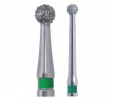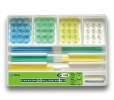MethodsTwenty new S-SMTDs from two different manufacturers (Nobel Biocare and Straumann: 10 of each type) were selected and divided into two groups, namely, case (group A) and control (group B). For sterilization, 100 cycles of autoclaving were performed in 100 sequences. In each sequence, 10 repetitions of peak torque values were registered for aging. To measure and assess the output of each device, a Tohnichi torque gauge was used (P<0.05). ResultsBefore steam sterilization, all of the tested devices stayed within 10% of their target values. After 100 cycles of steam sterilization and aging with or without dismantling of the devices, the Nobel Biocare devices stayed within 10% of their target torque. In the Straumann devices, despite the significant difference between the peak torque and target torque values, the absolute error values stayed within 10% of their target torque. ConclusionWithin the limitations of this study, there was no significant difference between the mean and absolute value of error between Nobel Biocare and Straumann S-S MTDs. INTRODUCTIONTorque generally refers to twisting or turning momentum and assesses the degree of screw and bolt tightening [1]. Accurate delivery of torque by mechanical torque devices (MTDs) to tighten dental implant prosthetic screws is necessary for safety against screw loosening, providing joint stability and prevention of over-tightening or stripping [2,3]. It is known that clinical use affects the accuracy of friction and spring-style mechanical torque devices (S-S MTDs) [4-6]. However, controversial findings concerning the accuracy of S-S MTDs have been reported. While some studies have shown S-S MTDs to be capable of producing accurate torque values within 10% of their target torque value [6] or with a slight decrease in delivered torque as a consequence of clinical use (aging) [7], in another study a high variability in the accuracy of S-S MTDs was reported and several of the tested devices were found to be inaccurate [5]. Dismantling of S-S MTDs before sterilization has been proposed by some manufacturers as a preparatory step, as corrosion may affect accuracy. This, however, is time consuming [4]. Additionally, the effect of component dismantling and aging (frequency of use) on the corrosion and accuracy of these devices remains unclear. In one study, steam sterilization did not affect the accuracy (±10 of the target torque) of dismantled devices [8]. However, the combined influence of dismantling of the S-S MTD components before sterilization and aging (frequency of use) on the accuracy of S-S MTDs has not been assessed. Due to the reported variability in the accuracy of S-S MTDs and the unclear reason for these controversial findings, this study aimed to assess the combined effect of dismantling of the components before sterilization and aging (frequency of use) on the accuracy (±10% of the target torque) of S-S MTDs. The null hypothesis was that there would be no significant difference in the accuracy of S-S MTDs after 100 autoclave cycles with dismantling of the components before sterilization and 1000 instances of use (aging). MATERIALS AND METHODSTwenty new S-S MTDs from two different implant manufacturers were evaluated for the combined effect of dismantling before steam sterilization and aging on their accuracy (within 10% of the target value). Considering other studies [7-9] and the effect size of 0.43 N·cm, and standard deviation (SD) of 0.18, a total sample size of 20 was calculated using a two-level factorial design. Ten S-S MTDs from each of the following manufacturers were selected 1) Nobel Biocare (Goteborg, Sweden) and 2) Straumann (Institut Straumann, Basel, Switzerland) and randomly assigned to two groups (5 samples of each manufacturer in each group) of case (group A) and control (group B) (Fig. 1). Dismantling of the components was performed for each device in group A according to the manufacturer's recommendations before each sterilization cycle. The S-S MTDs in group B were sterilized without dismantling the components. Before sterilization, the peak torque values were measured 10 times for each device. To measure the output (peak torque) of each S-S MTD at a predetermined target value designated by the manufacturer, a digital torque gauge (Tohnichi, Digital torque gauge BTGE, 50 CN, Tokyo, Japan) was used (Fig. 2). The target torque for all of the S-S MTDs was 35 N·cm. The torque gauge was calibrated to be accurate within ±2% of the full scale by the manufacturer. To measure the peak torque values of the S-S MTDs, the devices were first connected to the appropriate drivers. For the Straumann devices, an SCS screwdriver (length 27 mm, Art No. 046.402, Institut Straumann) and for the Nobel Biocare devices, a screwdriver machine (UniGrip 30 mm, 29153 with a manual torque wrench adapter prosthetic, Nobel Biocare) were used (Fig. 3). They were then clamped in a stable torque gauge (Fig. 4). To measure the peak torque values (10 times after each sterilization cycle), flexing of the beam in each device at a precalibrated target torque was determined visually. Force was applied slowly over 4 seconds [6]. All of the devices were immersed in artificial saliva (BioXtra, Solarfarma, Knokke, Belgium) before disinfection and steam sterilization procedures [8]. Dismantling of the components was performed for each device in group A before sterilization. After disinfection (Deconex 53 plus, Borer Chemie AG, Zuchwil, Switzerland) of the dismantled components, they were assembled before sterilization in Nobel Biocare devices (Fig. 5). However, the components were disinfected and then sterilized separately in Straumann devices (Fig. 6), as proposed by the manufacturer. After each sterilization, the target torque was assessed 10 times for each device and the peak torque values were registered by a digital torque gauge. The operator that applied the torque was blinded to the measured peak torque values. Dismantling of the components was performed for group A, with aging of the devices after each sterilization cycle. The abovementioned procedures were repeated for the devices in group B without dismantling of the components before each sterilization cycle.  Figure 1
Spring-style mechanical torque devices tested in groups with dismantling and aging, and without. Top: Nobel Biocare, Bottom: Straumann (ITI).
 Figure 2
The digital torque gauge showing the peak torque at a predetermined target value designated by the manufacturers.
 Figure 3
The appropriate driver was used to connect each spring-style mechanical torque device to the torque gauge.
 Figure 4
After connecting the devices to the appropriate drivers, they were clamped in a stable torque gauge.
 Figure 5
Nobel Biocare mechanical torque device.
 Figure 6
Straumann (ITI) device.
The absolute differences (raw error values), mean, and range of difference between the measured torque value and the target torque were evaluated before and after each sterilization cycle. Descriptive statistical analysis was used, and comparison of the mean of the error in each cycle was performed using the one-sample t-test. One-way repeated measures analysis of variance (ANOVA) for the type of S-S MTD and a between-subjects comparison was used to assess the difference in accuracy between the two types of devices in each group of MTD. Mixed ANOVA was used to assess the difference in accuracy (within 10% of the target torque) of the two types of S-S MTDs with a significance level of P<0.05. RESULTSThe statistical data for each group (Nobel Biocare, Straumann) of S-S MTDs is shown in Tables 1--4.4. Before sterilization, all of the tested S-S MTDs stayed within 10% of their target values. During and after 100 cycles of steam sterilization and aging with dismantling of the devices (Tables 1 and and2)2) and without dismantling of the components (Tables 3 and and4),4), the absolute error values stayed within 10% of their target torque (despite the significant difference between the peak torque and target torque values in the Straumann devices,P<0.05). The error bar and confidence interval of the mean raw error for both types of S-S MTDs are presented in Figs. 7 and and88.  Figure 7
Comparison of the raw error for the two types of spring-style mechanical torque devices in group A (with dismantling of the components). The error bar and 95% confidence interval of the mean raw error for two types of spring-style mechanical torque devices ...
 Figure 8
Comparison of the raw error for the two spring-style mechanical torque devices (S-S MTDs) of group B (without dismantling of the components before sterilization). The error bar and 95% confidence interval of the mean raw error for two groups of S-S MTDs ...
 Table 1
The mean, standard deviation (SD), and range of difference between the peak torque and target values before (X0) and during 100 steam sterilization cycles with both dismantling of the components (group A) and aging (X1-X100) of the Straumann (ITI) devices. ...
 Table 2
The mean, standard deviation (SD), and range of difference between the peak torque and target values before (X0) and during 100 steam sterilization cycles with both dismantling of the components (group A) and aging (X1-X100) of the Nobel Biocare devices. ...
 Table 3
The mean, standard deviation (SD), and range of difference between the peak torque and target values before (X0) and during 100 steam sterilization cycles without dismantling of the components (group B) or aging (X1-X100) of the Straumann (ITI) devices. ...
 Table 4
The mean, standard deviation (SD), and range of difference between the peak torque and target values before (X0) and during 100 steam sterilization cycles without dismantling of the components (group B) or aging (X1-X100) of the Nobel Biocare devices. ...
DISCUSSIONScrew loosening has been reported to be a common technical problem in implant-supported fixed dental prostheses both with and without cantilever extension [10-12], and in implant-supported crowns [13,14]. Lower preload application to screw joints resulted in dynamic fatigue and greater micromotion at the implant and abutment junction [15]. There was no statistically significant difference in error values (difference between the measured peak torque and target values) for the combined influence of dismantling before steam sterilization and aging in S-S MTDs. Low variability and a small range of values were seen in these S-S MTDs and the absolute values of the errors stayed within 10% of their target torque, representing their accuracy. Performing the preparatory steps before sterilization has not been assessed in previous studies with regard to affecting the accuracy of S-S MTDs. Cehreli et al. [7] assessed the accuracy of S-S MTDs used in clinical practice 500 to 1,000 times and found that these devices delivered a consistent torque output, with a slight decrease subsequent to clinical use. McCracken et al. [6] also examined the accuracy of S-S MTDs in clinical service and reported on their accuracy (within 10% of the target torque) and low variability of delivered torque (SD, +1 N·cm). They found that the life span of these devices ranged from an estimated 18 months to 7 years of clinical use (representing up to 700 instances of clinical use and sterilization cycles). The results of our study showed that aging with or without dismantling of the components did not affect the accuracy of the S-S MTDs. This finding supports similar results of previous studies that reported a high consistency and accuracy of S-SMTDs in clinical use [6,7]. However, high variability and inaccuracy have been reported in spring-style devices that were in use for less than 2 years. Santos et al. [5] demonstrated inaccuracy in several of the S-S MTDs that they tested (Biomet 3i, Nobel Biocare; Conexao, Straumann); for a 20-N·cm target torque value, 62.5% of the measured values were accurate (within 10% of the target value). For a 32-N·cm target torque, however, only 33.3% of all of the values from each manufacturer were considered accurate. Compared with the results of our study, these controversial findings suggest a lack of care in performing the meticulous routine steps for preparation of the devices before autoclaving (dismantling, cleaning), because without dismantling of the components, the absolute values of the errors always stayed within 10% of their target torque, confirming the accuracy of these devices. Aging has been reported to be a factor influencing the accuracy of friction-style mechanical torque limiting devices. However, Mahshid et al. [8] examined the effect of steam sterilization, without aging, on the accuracy of new S-S MTDs, and their results showed that 100 cycles of autoclaving with dismantling of the components before sterilization of Straumann and Nobel Biocare devices did not affect the accuracy of S-S MTDs. Comparing this finding with the results of our study suggests that aging (1,000 instances of use) did not affect the accuracy of these devices. Vallee et al. [9] assessed the accuracy of new MTDs and reported minimal and similar variation of mean torque values from the target torque in S-S MTDs. This finding supports the results of our study. Dismantling and assembling the parts of Nobel Biocare devices and dismantling and autoclaving the components separately for Straumann devices have been proposed by the manufacturers as preparatory steps before autoclaving. The results of our study did not show any significant difference between the means of the measured torque and maximum absolute value of error between Nobel Biocare and Straumann devices after 100 cycles of steam sterilization and aging with or without dismantling of the devices. It should be noted that, in the analysis of the study data, the mean errors are not as important as the extreme variations recorded in the full range of torque output. The extremes are the torque values that will be most likely to cause problems [16]. For the purpose of this study, the maximum values of the delivered torque were reported, and torque values within 10% of the target torque were considered to demonstrate accuracy of the tested devices [6,8,16]. Dismantling of the components before autoclaving did not affect the accuracy of the S-S MTDs. Future observations on the microbiological aspects of dismantling the components in the clinical context may be needed to verify the necessity of this time-consuming step before autoclaving of S-S MTDs. In conclusion, within the limitations of this study, we conclude that:
ACKNOWLEDGEMENTSThis work has been sponsored by the Research Council of the Shahid Beheshti University of Medical Sciences School of Dentistry. The authors would like to express their appreciation to Dr. Mohammad Javad Kharazi Fard for statistical evaluation. FootnotesNo potential conflict of interest relevant to this article was reported. References1. Tsuruoka M. Tohnichi torque handbook. Vol. 7 Tokyo: Tohnichi Mfj Co.; 2008.
2. Haack JE, Sakaguchi RL, Sun T, Coffey JP. Elongation and preload stress in dental implant abutment screws. Int J Oral Maxillofac Implants. 1995;10:529–536. [PubMed]
3. Guda T, Ross TA, Lang LA, Millwater HR. Probabilistic analysis of preload in the abutment screw of a dental implant complex. J Prosthet Dent. 2008;100:183–193. [PubMed]
4. Gutierrez J, Nicholls JI, Libman WJ, Butson TJ. Accuracy of the implant torque wrench following time in clinical service. Int J Prosthodont. 1997;10:562–567. [PubMed]
5. Santos GC, Jr, Passos SP, Coelho Santos MJ. Accuracy of mechanical torque devices for implants used in Brazilian dental offices. Int J Prosthodont. 2011;24:38–39. [PubMed]
6. McCracken MS, Mitchell L, Hegde R, Mavalli MD. Variability of mechanical torque-limiting devices in clinical service at a US dental school. J Prosthodont. 2010;19:20–24. [PubMed]
7. Cehreli MC, Akca K, Tonuk E. Accuracy of a manual torque application device for morse-taper implants: a technical note. Int J Oral Maxillofac Implants. 2004;19:743–748. [PubMed]
8. Mahshid M, Saboury A, Fayaz A, Sadr SJ, Lampert F, Mir M. The effect of steam sterilization on the accuracy of spring-style mechanical torque devices for dental implants. Clin Cosmet Investig Dent.2012;4:29–35. [PMC free article] [PubMed]
9. Vallee MC, Conrad HJ, Basu S, Seong WJ. Accuracy of friction-style and spring-style mechanical torque limiting devices for dental implants. J Prosthet Dent. 2008;100:86–92. [PubMed]
10. Kreissl ME, Gerds T, Muche R, Heydecke G, Strub JR. Technical complications of implant-supported fixed partial dentures in partially edentulous cases after an average observation period of 5 years. Clin Oral Implants Res. 2007;18:720–726. [PubMed]
11. Zurdo J, Romao C, Wennstrom JL. Survival and complication rates of implant-supported fixed partial dentures with cantilevers: a systematic review. Clin Oral Implants Res. 2009;20(Suppl 4):59–66. [PubMed]
12. Aglietta M, Siciliano VI, Zwahlen M, Bragger U, Pjetursson BE, Lang NP, et al. A systematic review of the survival and complication rates of implant supported fixed dental prostheses with cantilever extensions after an observation period of at least 5 years. Clin Oral Implants Res. 2009;20:441–451. [PubMed]
13. Jung RE, Pjetursson BE, Glauser R, Zembic A, Zwahlen M, Lang NP. A systematic review of the 5-year survival and complication rates of implant-supported single crowns. Clin Oral Implants Res.2008;19:119–130. [PubMed]
14. Pjetursson BE, Bragger U, Lang NP, Zwahlen M. Comparison of survival and complication rates of tooth-supported fixed dental prostheses (FDPs) and implant-supported FDPs and single crowns (SCs) Clin Oral Implants Res. 2007;18(Suppl 3):97–113. [PubMed]
15. Gratton DG, Aquilino SA, Stanford CM. Micromotion and dynamic fatigue properties of the dental implant-abutment interface. J Prosthet Dent. 2001;85:47–52. [PubMed]
16. Standlee JP, Caputo AA, Chwu MY, Sun TT. Accuracy of mechanical torque-limiting devices for implants. Int J Oral Maxillofac Implants. 2002;17:220–224. [PubMed]
Source:Published online 2013 Oct 29. doi:10.5051/jpis.2013.43.5.221
|
Send Money, Transfer Money or Pay Online with PayPal
The combined effect of dismantling for steam sterilization and aging
Related products
Jota - Diamond Burs - Round - FG

Tor VM - Finishing & Polishing Kit (Stem Disc+Strip)

Tor VM - Wooden Wedges of 6 Types

Taksan - Dr.Roufi Tray


